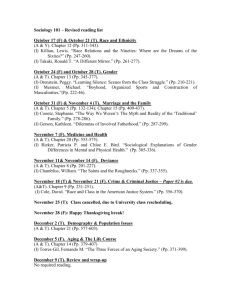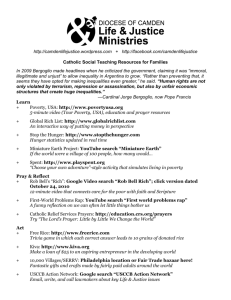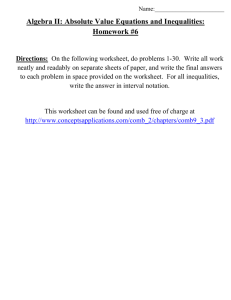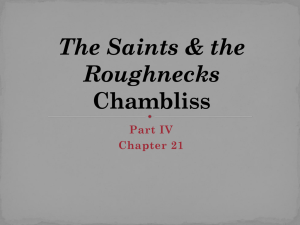Media and Money
advertisement
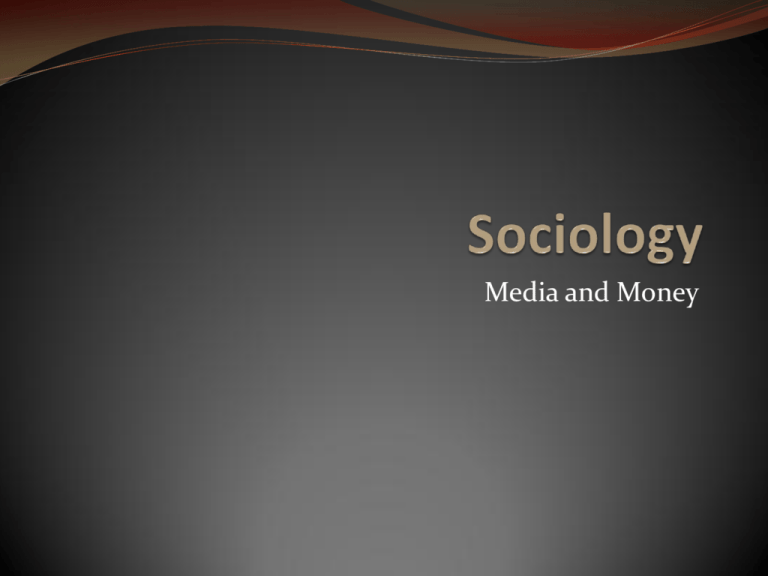
Media and Money Media Immersion The signs on billboards, busses, taxis, park benches, and just about everywhere someone goes. Clothes Shopping bags, soda cans, fast food cups. These things all affect our “reality”. The words we associate… “chapstick” “bubblewrap” “magic marker”… are all made up words that have become part of our realities. Every day we see 300-1,500 ads. $900 per person is spent on an ad. $220 billion per year. Media Immersion Ideal beauty : How advertising shapes body image. Some ads are positive Advertising creates anxieties and fears and then says we can solve them through consumerism. Advertising also fosters competition, especially between women in the media created beauty contest. It is very common to use the female body to sell all type of products for men and women. In extreme cases the woman body becomes the product, as in pornography. Media Immersion Labeling Theory Labeling theory began in the 1970’s Vietnam Civil Rights Hippie Rebellion Many social institutions were being challenged and assumptions were questions Tannenbaum: The dramatization of evil A person becomes the thing they are described as being If someone calls someone deviant, they are likely to become deviant and sometimes more so than they were before. Labeling Theory In general the theories argue that becoming stigmatized or labeled by agents of social control, including official institutions such as the police and the courts, or unofficial institutions, such as parents and neighbors, is what creates and sustains delinquent careers. Questions to be answered… Why are certain behaviors defined as “delinquent?” Why are certain “individuals” labeled delinquent? What is the effect of the label? Chambliss: Suggests 3 crucial factors in the labeling of individuals Visibility of delinquency Personal disposition of offender Mobilization of community bias Questions to be answered… Saints and Roughnecks During the 1970’s Chambliss conducted a 2 year study involving interviews and observations of 2 groups of high school boys. 8 White men that had ‘promising futures’ (saints) 6 Lower class white men (roughnecks) The Saints would drive out to the bad side of town and get into trouble on weekends. Society reacted by saying “boys will be boys”. The roughnecks did similar things but were labeled as delinquents and punished more. Questions to be answered… Society created distrust and developed fear. Visibility: The saints had cars to move around in. The roughnecks walked and hung out in pool halls, restaurants, and on street corners together. Demeanor: Polite cooperation (saints) and hostility and disdain (roughnecks). *Class bias was evident between the middle and lower classes. The Question of Sanity Rosenhan: On Being Sane in Insane Places. How accurate are diagnoses of insanity? Are they made based on the individual or environment? 8 volunteers have themselves committed to 12 different psychiatric wards in 5 different states, all are completely sane. 1 Psychologist grad student,3 psychologists, 1 pediatrician, 1 psychiatrist, a painter and a housewife. 11/12 are admitted with schizophrenia and 1 was diagnosed with manic depression after they claimed “I hear voices!” The Question of Sanity As soon as they were admitted the ‘patients’ stopped hearing voices and were acting as they normally would. Cooperative, kind, however they would be (no more faking). All were released by they were considered to be ‘in remission’ and were never considered to be fully cured. Hospitalization lasted 7-52 days. The label of schizophrenia was so powerful that the hospital staff began to interpret “normal” behavior as abnormal. This just says that once a label is applied, everything becomes associated with the label. Income Inequalities Modern American culture is stratified through a “class system” Anthony Giddens identifies 4 characteristics of the class system: Its fluid, that is the boundaries between levels are not clear cut or well defined. Class positions are to some extent achieved. Social mobility is possible even if positions are economically based. Large scale and impersonal focus is on impersonal associations and occupational categories, not individuals. Income Inequalities Intragenerational: Within ones own lifetime they move through the levels. Intergenerational: Between 2 or more generations. Class in America: Capitalist Upper middle class Lower middle class Working class Working class Underclass Income Inequalities Capitalist: Educated or prestigious universities Heirs, investors, top level executives Income exceeds $500,000 1% of the population Upper Middle Class Educated at college level with a graduate education Employed as professionals and upper managers $100,000 plus 15% of population Income Inequalities Lower Middle Class High school/College level Employed as semiprofessionals, lower management, and craftspeople $60,000 34% of the population Working Class High school level Employed as factory workers, clerical staff, crafts, etc. $35,000 30% of the population Income Inequalities Working Poor Some high school education Employed as laborers, service workers, and low paid sales people Income around $17,000 16% of the population Underclass Some high school Unemployed or part time Income under $10,000 4% of the population Income Inequalities Cultural Capital: The taste, attitudes, language and thoughts, that convey social class. Homes Education level Appearance Leisure activities Economic Distribution 2004 median income is $44,389 and the mean is $60,528. This is because there are a lot of very wealthy people in the United States. Geographic distribution: Northeast $47,994 West $47,680 Midwest $44,657 South $40,773 Median household wealth = $93,000 Mean would be $448, 200 In the 1990’s 1% of the US owned 38% of the wealth and 20% controlled 83.9% Economic Distribution In 1996 140 billionaires existed. There are now over 800 with many in the US. $1,000,000,000,000 Who’s who among the wealthy? Bill Gates = 53 billion Warren Buffet = 46 billion All white. Any woman on the list of billionaires inherited their wealth. #77 most wealthy is the first non-white #140 I when minorities are “consistent” Oprah is #242 and 1st African American! Go OPRAH! OPRAH!!! Who Rules America? Mills argued that a power elite rules the country. Top corporate, military, political leaders The middle class elite exists just below Huge interest groups and congress members Under that lies the rest of America Poverty in America 12.7% of 37 million Americans live in poverty 14.4% of New Yorkers live in poverty. Poverty is: Single, individual, under 65, income under $10,488 Two adults under 65, income under $13,500 Two adults and one child, income under $17,000 Africans and Latinos are two times more likely to be poor than Caucasian Americans. An American’s risk of poverty has been stable since 1970. The Effects Children: Higher risk of deafness, blindness, death in childhood, fatal accidental incidents, lower IQ scores. The failure of hard work: Almost ½ of the poor are either too old or too young to work in full time employment. 35% are under 18 9% are over 65 A minimum wage worker only earns 82% of the poverty level income for a family of three. The Welfare State The notion that America’s poor survive on welfare is unfounded. 50% of the income of poor adults comes from wages and pensions. 25% comes from welfare. 22% comes from social security. The fact is that the majority of government aid goes to the non-poor. More goes to agribusiness, banks, corporations, and defense industries. The Welfare State There is over $12 billion in tax avoidances by transnational corporations annually.
